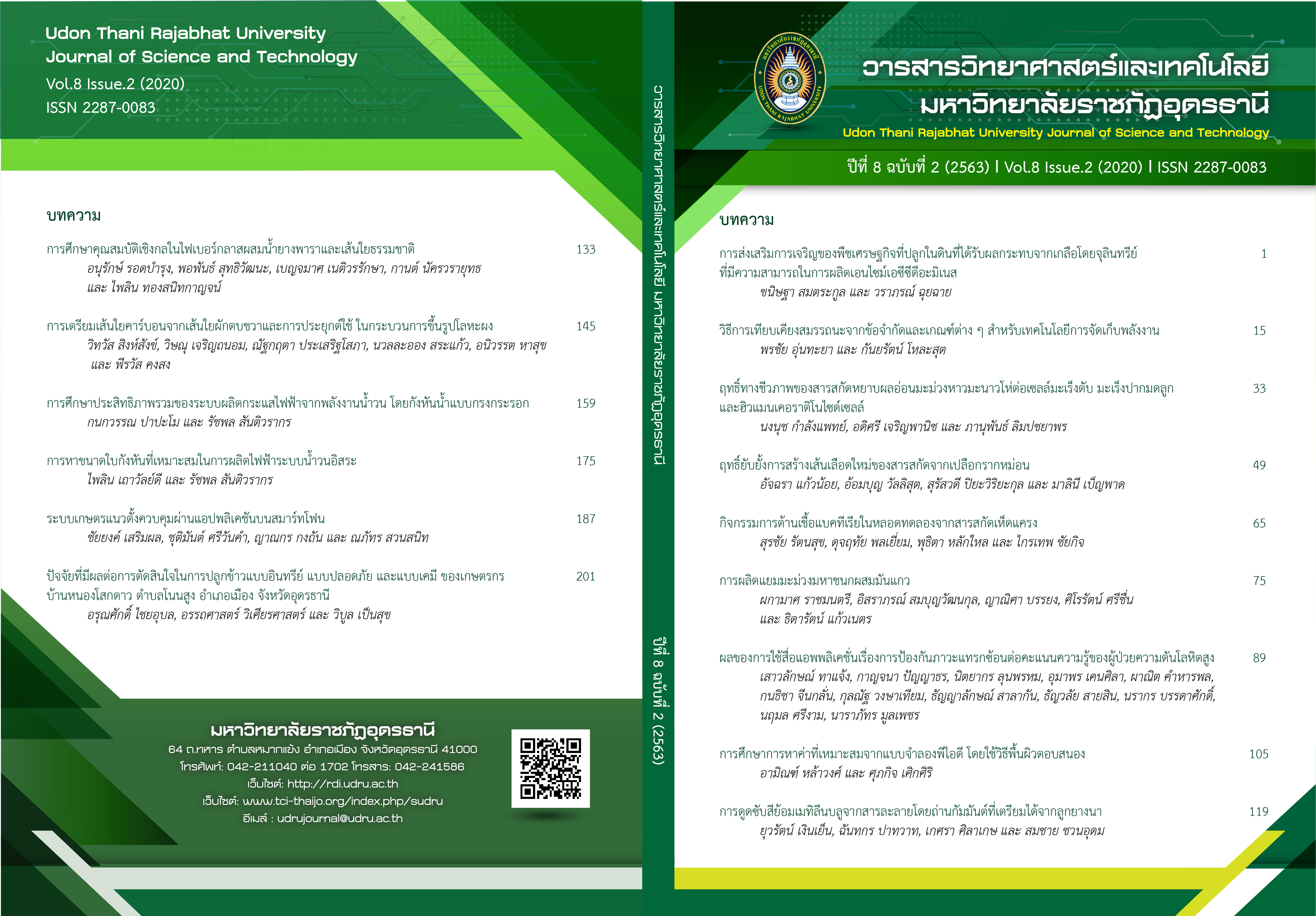กิจกรรมการต้านเชื้อแบคทีเรียในหลอดทดลองจากสารสกัดเห็ดแครง
Main Article Content
บทคัดย่อ
จุดประสงค์ของการศึกษาครั้งนี้ คือ เพื่อศึกษากิจกรรมการต้านแบคทีเรียก่อโรคในหลอดทดลองจากสารสกัดเห็ดแครง โดยสกัดสารออกฤทธิ์จากเห็ดแครงด้วยตัวทำละลาย 4 ชนิด คือ Hexane, Dichloromethane, Ethyl acetate และ Methanol นำสารสกัดไปทดสอบกิจกรรมการต้านเชื้อแบคทีเรียก่อโรค 6 ชนิด (Bacillus subtilis TISTR 008, Escherichia coli TISTR 780, Staphylococcus aureus TISTR 1466, Staphylococcus epidermidis TISTR 518, Pseudomonas aeruginosa TISTR 1383, Klebsiella pneumonia subsp. Pneumonia TISTR 1383) ผลการศึกษาพบว่าค่า Minimum Inhibitory Concentration (MIC) อยู่ระหว่าง 0.15-2.5 มิลลิกรัมต่อมิลลิลิตร พบว่าสารสกัดจากเห็ดแครงที่สกัดด้วย Ethyl acetate ที่ค่า MIC ต่ำสุดต่อเชื้อ Staphylococcus aureus TISTR 1466 เท่ากับ 0.15 มิลลิกรัมต่อมิลลิลิตร รองลงมาเป็นสารสกัดจากเห็ดแครงที่สกัดจาก Hexane มีค่า MIC เท่ากับ 0.62 มิลลิกรัมต่อมิลลิลิตร ผลการศึกษาพบว่ามีเพียงสารสกัดจากเห็ดแครงที่สกัดด้วย Ethyl acetate เพียงชนิดเดียว ที่แสดงค่า Minimum Bactericidal Concentration (MBC) ต่อเชื้อ Staphylococcus aureus TISTR 1466 เท่ากับ 1.25 มิลลิกรัมต่อมิลลิลิตร การศึกษาครั้งนี้เป็นการรายงานผลของกิจกรรมการต้านเชื้อ Staphylococcus aureus จากสารสกัดของเห็ดแครงเป็นครั้งแรกซึ่งเป็นประโยชน์ต่อการพัฒนาทางเภสัชกรรม
Article Details
เอกสารอ้างอิง
ไซนะ มูเล็ง. (2555). การใช้ประโยชน์จากวัสดุเหลือทิ้งทะลายปาล์มเปล่าและทางใบปาล์มน้ำมันเพื่อการเลี้ยงเชื้อเห็ดแครง (Schizophyllum commune) และการผลิตสาร Schizophyllan. (วิทยานิพนธ์วิทยาศาสตรมหาบัณฑิต, มหาวิทยาลัยสงขลา นครินทร์)
สุจิตรา โนนทิง. (2561). การพัฒนาเครื่องสำอางลดริ้วรอยซึ่งมีเบต้ากลูแคนที่สกัดจากเห็ดแครง. (วิทยานิพนธ์วิศวกรรมศาสตรมหาบัณฑิต, จุฬาลงกรณ์มหาวิทยาลัย)
Berfilamen, P., Teoh, Y. P., & Don, M. M. (2013). In vitro antifungal activities and phytochemical analysis of filamentous white-rot fungi, Schizophyllum commune. Sains Malaysiana, 42(9), 1267-1272.
Khardziani, T., Metreveli, E., Didebulidze, K., & Elisashvili, V. I. (2020). Screening of Georgian Medicinal Mushrooms for Their Antibacterial Activity and Optimization of Cultivation Conditions for the Split Gill Medicinal Mushroom, Schizophyllum commune BCC64 (Agaricomycetes). International Journal of Medicinal Mushrooms, 22(7), 659-669.
Manthey, K. C., Rodriguez-Melendez, R., Hoi, J. T., & Zempleni, J. (2006). Riboflavin deficiency causes protein and DNA damage in HepG2 cells, triggering arrest in G1 phase of the cell cycle. The Journal of nutritional biochemistry, 17(4), 250-256.
Mirfat, A., Noorlidah, A., & Vikineswary, S. (2014). Antimicrobial activities of split gill mushroom Schizophyllum commune Fr. American Journal of Research Communication, 2(7), 113-124.
Papadopoulou, C., Soulti, K., & Roussis, I. G. (2005). Potential antimicrobial activity of red and white wine phenolic extracts against strains of Staphylococcus aureus, Escherichia coli and Candida albicans. Food Technology and Biotechnology, 43(1), 41-46.
Suay, I., Arenal, F., Asensio, F. J., Basilio, A., Cabello, M. A., Díez, M. T., & Hernández, P. (2000). Screening of basidiomycetes for antimicrobial activities. Antonie Van Leeuwenhoek, 78(2), 129-140.
Rattanasuk, S., & Phiwthong, T. (2020). Evaluation of the Antibacterial Activity of Spathiphyllum wallisii Extracts Against Human Pathogenic Bacteria. Pakistan Journal of Biological Sciences, 23, 1436-1441.
Yelithao, K., Surayot, U., Lee, C., Palanisamy, S., Prabhu, N. M., Lee, J., & You, S. (2019). Studies on structural properties and immune-enhancing activities of glycomannans from Schizophyllum commune. Carbohydrate Polymers, 218, 37–45.


